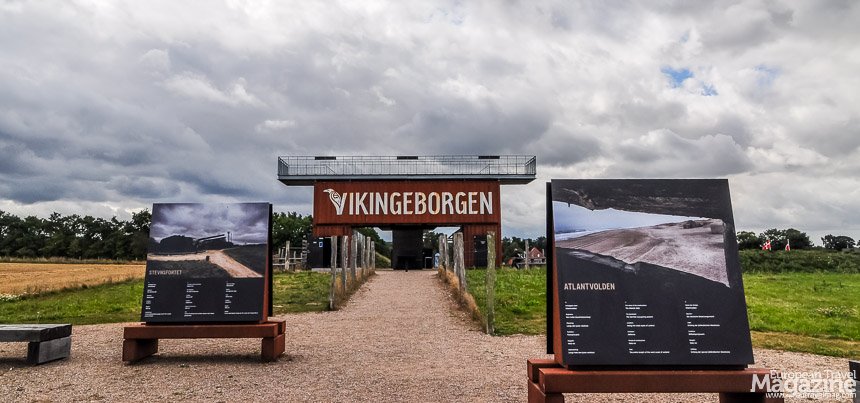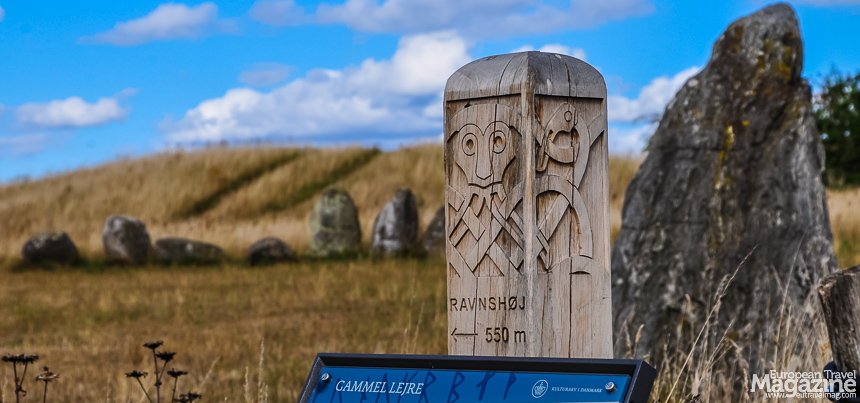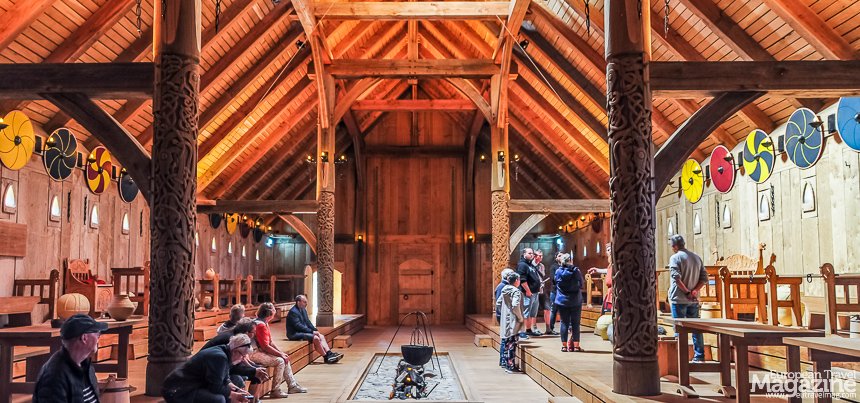We continue our quest for clues about the Vikings in Denmark: How they lived & died, what they believed in and how they fared in this epoch between prehistory and ancient history. The Viking Age was born out of the Iron Age and defined the beginning of the Middle Ages in Northern Europe. It was a time of human evolution, improvement and advancement – culturally and geographically. Follow us, as we discover the centres of previous power, dive into Viking legends, and use new technology to learn from the archaeologists.
We’ve previously covered the Viking sites in western Denmark; in Jylland and Fyn. Now we turn our gaze to Zealand, the largest island in Denmark proper and eastern part of the Kingdom. This was the geographical centre of Denmark at the time of the Vikings, as the areas of Skåne, Halland & Blekinge – now part of Sweden – also formed part of the Danish Viking Kingdom. Zealand was a powerhouse of exploration and conquest. And you can discover its significance at these Vikings sites:
Vikingeborgen Borgring
In 2014, archaeologists discovered a forgotten Viking Castle. At this unusual museum, we got up close and personal with the archaeologists who are trying to solve the mystery of this huge construction that disappeared from history without a trace.
As we arrived at the museum, we had a chance to climb the containers, that constitute the museum at this early stage, to get an impression of the scale of this ring castle, which like we’ve seen many other places in Denmark too; like Fyrkat and Aggersborg in West Denmark and Trelleborg here on Zealand (check it out below). But where the other sites can boast a circle rampart, here, it was erased over the course of centuries. Instead, monuments present the enormous ring castle, and helps you imagine just how impressive a construction it was. We did not merely encounter a hole in the ground, but a spectacular testament to one of the largest constructions of the Viking age!
Another thing that made Vikingeborgen stand out, was the use of technology to tell the story about both the findings, but just as important: the excavation. Here, the archaeologists are the protagonists of the story, not the Vikings, and that helps in understanding and appreciating the work gone into unearthing this ancient powerhouse. At designated spots throughout the site you can put on the special VR glasses on your Smartphone and, via the downloaded App, view 360⁰ videos of the excavation and interviews with the archaeologists.
However, the last – and most important thing – that made Vikingeborgen one of our favourite Viking sites on Zealand, was the guide taking us through the site, explaining us the history and the theories about the rings castles of Denmark. Lars Beck Nielsen was passionate about the history, and made this Viking Castle come alive while sharing facts and theories about its Viking past.
As of now, Vikingeborgen Borgring remains closed, as they are currently working on realizing the plans for a 1.800 m2 experience centre connected to the site. We look forward to see it again when it reopens, and hope that they’ll continue to make it an engaging exhibition, using those knowledgeable guides.
Nationalmuseet

The Danish National Museum is an obvious no-miss for any history buff coming to visit Copenhagen. Its logical design of spaces makes it easy to navigate the Danish history in chronological order, and the visual presentation stimulates your curiosity. More so in the current Viking exhibition; “Join the vikings – on “The Raid”.
The exhibition assembles the most important Viking finds and treasures and binds them together with stories: A beautiful cinematic story, telling the tale of Bjørn Ironside’s raid of the Meditarrenan Sea, using the world’s largest Viking ship to frame the story of the adventurous raid. Interactive screens combine facts with fables. Large cartoon drawings of ancient Viking kings and queens portray their individuality and depict their characteristics.
These personalised stories give new life to the dead treasures, as we appreciate the human accomplishment behind them. And what treasures there are to be eye-balled! Gold and silver adornments, coins, brooches and bracelets. But also treasures of another kind: Two Viking relatives reunited after 1.000 years!
One of the Vikings died in England in his 20s in the 11th century, from injuries to the head and was buried in a mass grave in Oxford. The other died in Denmark in his 50s, his skeleton bearing traces of blows that suggest he took part in battles. A unified European eftort to map DNA of skeletons from the Viking era enabled archaeologists to determine by chance that the two were related. And you can see them lying side by side until at least 2024 when the exhibition ends.
VikingeskibsMuseet Roskilde

Around the year 1070, five Viking ships were deliberately sunk at Skuldelev in Roskilde Fjord in order to block the most important fairway and to protect Roskilde from an enemy attack from the sea. These ships, later known as the Skuldelev ships, were excavated in 1962 and the Viking ship museum was created to house them.
First if all, it’s quite beautiful to witness the old remains of these proud vessels in the majestic hall built in 1969 specifically to accommodate them. Against a huge window looking out into Roskilde Fjord, from where they were excavated, they look like Viking sculptures looking out to their former element.
What makes the museum special, though, is the unique synergy between the exhibition of the original Viking ships and the museum’s interactive environment, where you can experience reconstructed Viking ships, excellent boatbuilding and specialized, maritime crafts.
VikingeskibsMuseet Roskilde is not merely a giant display case, showing off dead relics, but a living workshop, where boat builders, archaeologists and sailors get together to make Viking maritime history come alive.
The museum’s success is written in the reconstructed ships, you can study in the historic harbour next to the exhibition hall, and in the workshops that tell – and show – you how the ships were built using historically recorded tools and natural materials. You can discover more than 40 reconstructed ships, with 15 from the Viking Age, in the harbour and – if you want to challenge your inner Viking – you can even climb on board one of the Viking ships’ direct descendants; the traditional Nordic wooden boats, and go sailing in the summer months.
In the late 1990s, excavations for the shipyard expansion of the museum uncovered 9 more ships from the Viking Age and early medieval period. It was the largest discovery of prehistoric ships in Northern Europe and included the longest Viking warship ever found: the Roskilde 6 at 36 metres. VikingeskibsMuseet Roskilde is truly a living testament to the engineering and seafaring skills of the Vikings.
Lejre Museum









According to legends, it was in Lejre that Denmark’s first royal family, Skjoldungerne, had their power base before and during the Viking Age. Although Skjoldungerne are merely legend kings, Lejre Museum’s archaeological findings support the thesis that Denmark’s birth certificate may be found in Old Lejre. Check out for yourself the archaeological remains of some of the grandest buildings of ancient times; the 650 m² large King Halls, that are located just a short walk from the museum. You can really feel the presence of history, when you stand among the mounds and ramparts and look at the landscape.
Lejre is said to have been the centre of power and the king’s seat in the Viking Age and in the Neolithic period – not just for a single king or for a short period of time, but for more than 500 years! Over the past three decades, excavation upon excavation has painstakingly added new pieces to the historic puzzle, which clearly shows that Lejre’s legend kings must re-take their place in Danish history books.
Based on the archaeological finds, the museum displays a permanent exhibition called Sagnkongernes Lejre, where you can experience and immerse yourself in the history of the Lejre area through the use of sound, light and interactive design – and get up close and close to Denmark’s largest silver treasure: the Mannerup treasure.
The museum itself is located inside a four-winged thatched farm from the 1800s and the whitewashed walls are perfect as backdrop for the exhibitions. It’s great fun to scan the many finds with a QR code scanner and discover the details, or read the epic poem of Beowulf. And the museum shop is really the perfect place to find historic, curious and tasty souvenirs to make that Viking impression last a little longer.
- Lejre Museum website (in Danish)
Lejre – Land of Legends
Denmark’s largest Viking Hall – the one you just visited the archaeological remains of near Lejre Museum – is reconstructed in this open-air historic village, that’s buzzing with activity each summer as well as school holidays. Lejre – Land of Legends brings 10.000 years of Danish history to life. Houses and settings from the Iron Age, Stone Age, Viking Age and the 19th century, historic workshops and domestic animals are all located in the beautiful historic landscape.
Its prize feature is this so-called King’s Hall that began construction in 2018 and won the Carpenter Award in 2020. More than 1.000 tons of Danish oak wood has been used to create this epic, 600 m² hall. What adds to its exceptionality is the combination of using CNC machines and skilled carpenters to create the intrinsically carved woodcarvings. They are extraordinary. So is the mere scale of the building. Wow!
After you’ve appreciated the artistic accomplishment of the King’s Hall, it’s time to venture into the open-air museum that is Lejre – Land of Legends. It’s a very educating stroll amongst the many houses and workshops, where you get close to ancient methods of cooking, weaving, dying and other everyday chores of a past not so long ago.
Lejre is so much fun for the whole family, and if you’re keen on being a Viking for more than just a day of visit, you can actually become VacationViking, spend a week in the open air museum to be a part of the re-enactment and vivify the history.
Trelleborg
Trelleborg is one of five Danish ring castles built under King Harald Bluetooth, who ruled Denmark from 958 to 987. Harald Bluetooth kept his country in an iron grip, and the ring fortifications were part of the strategy the king and his builder had put in place to unite Denmark. Therefore, the castles were also located in strategic locations in the Danish landscape – Trelleborg at Slagelse, Vikingeborgen Borgring at Køge, Nonnebakken in Odense, Fyrkat at Hobro and the largest: Aggersborg at Løgstør.
The large castles, built as a unified vision with great engineering and outrageous costs for both population and royal power, played a central role in Danish history at the end of the 900s. Even though the castles were different in size, they are nevertheless so similar in construction and execution that there is no doubt that they have the same author, and thus all are part of the same piece of Danish history. But even in their size difference, there’s a symmetry: Aggersborg has an inner diameter of 240m, while Trelleborg’s inner diameter is 136m, and the diameter of Fyrkat, Nonnebakken and Vikingeborgen Borgring is 120m – half of Aggersborg’s size.
The 5 ring castles are all included in UNESCO’s tentative list of World Heritage Sites and they have submitted an application for inclusion on the UNESCO World Heritage List. That decision is made July 2022.
Trelleborg is the most visited of those 5 ring castles, as it has been excavated the longest time, since the 1930s, and a museum in place has educated visitors since 1995. Ring castles are even called Trelleborge in Danish, and so this is the perfect spot to be informed about ring castles and their historic significance. During holidays, Trelleborg offers visitors a wealth of activities, displays and events. You can bake flat bread, fire a Viking longbow, paint a shield or a sword, carve your name with ancient Viking runes or cast jewellery made of tin.
And have I mentioned there’s a great Museum shop?
- Trelleborg website
- Viking-Age Ring Fortresses on Danish National Museum’s website
- Trelleborg on Wikipedia
Learn more
There are more Viking sites to discover in the western part of Denmark, which you can learn more about in our article In the Footsteps of the Vikings: West Denmark. But there are lots of other things to do if you’re in Denmark. If you are in the northern part of Jutland you MUST visit Skagen – here’s our take on Top5 Things to do in Skagen. If you’re in Zealand, how about following in the footsteps of The Kings of the North to find out how royalty shaped this part of Denmark in the Middle Ages.
Here are some more useful links if you want to dig deeper into Denmark – or Vikings!
- Viking Age Ring Fortresses on Unesco
- VisitDenmark official Tourism website
- VisitDenmark’s guide to Top10 Viking sites
- Vikings on Wikipedia
- Viking Age on Wikipedia

























































